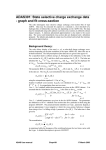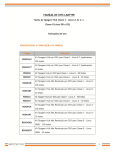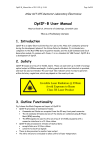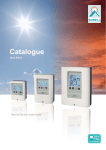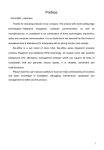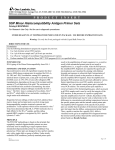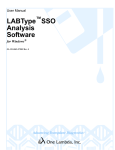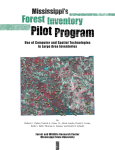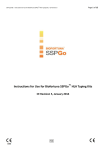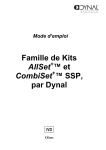Download LABType SSO Typing Tests, ENGLISH VERSION
Transcript
21001 Kittridge Street, Canoga Park, CA 91303-2801 Tel: (818) 702-0042 Fax: (818) 702-6904 P R O D U C T www.onelambda.com I N S E R T LABType® SSO Typing Tests Catalog #s: See LABType® SSO Typing Tests Reference Table for catalog IDs covered by this product insert. For In Vitro Diagnostic Use. Table of Contents Intended Use ................................................................................... 1 Summary and Explanation.............................................................. 1 Principles ......................................................................................... 1 Reagents ......................................................................................... 1 Instrument Requirements................................................................ 3 Specimen Collection and Preparation ............................................ 3 Procedure ........................................................................................ 3 A. Materials Provided .......................................................... 3 B. Materials Required, but Not Provided ............................ 3 C. Materials Recommended, but Not Provided.................. 4 D. Step-by-step procedure.................................................. 4 Directions for Use ............................................................................4 A. Bead Handling and Storage ...........................................4 B. Amplification ....................................................................4 C. Test Set-Up .....................................................................5 D. Test Procedure ...............................................................6 Results ...........................................................................................8 Limitations of the Procedure ...........................................................8 Expected Values ..............................................................................9 Specific Performance Characteristics .............................................9 Bibliography ...................................................................................10 Licensing, Patents, and Trademarks ............................................10 European Authorized Representative...........................................10 Summary of Protocol for 96-Sample Assay..................................11 INTENDED USE DNA typing of HLA Class I or Class II alleles. SUMMARY AND EXPLANATION Historically, the established method for the determination of HLA antigens has been the lymphocytotoxicity test.1 However, with the advent of PCR technologies, DNA based tissue typing techniques have become routine in the laboratory. For most DNA-based methodologies, the PCR process is used only as an amplification step to acquire the needed target DNA. The HLA typing process then requires a post-amplification step to discriminate between the different alleles (e.g., RFLP, SSOP, reverse dot blot). LABType® SSO uses sequence-specific oligonucleotide probes (SSO) bound to fluorescently coded microspheres to identify alleles encoded by the sample DNA. The introduction of a step to amplify the target DNA by polymerase chain reaction (PCR), coupled with hybridization and detection in a single reaction mixture, makes this method suitable for both small and large-scale testing. In contrast to the lymphocytotoxicity reaction scale (1 = negative to 8 = positive), LABType® test results are either positive or negative. This abolishes the need for complicated interpretation of results. In addition, single nucleotide changes can be discriminatory in PCR-SSO, while cross-reacting groups (CREGs) provide major challenges to serological typing. PRINCIPLES LABType® applies Luminex® technology to the reverse SSO DNA typing method. First, target DNA is PCR-amplified using a group-specific primer. The PCR product is biotinylated, which allows it to be detected using R-Phycoerythrin-conjugated Strepavidin (SAPE). The PCR product is denatured and allowed to rehybridize to complementary DNA probes conjugated to fluorescently coded microspheres. A flow analyzer, the LABScan™ 100, identifies the fluorescent intensity of PE (phycoerythrin) on each microsphere. The assignment of the HLA typing is based on the reaction pattern compared to patterns associated with published HLA gene sequences. REAGENTS A. Identification The LABType® SSO DNA typing system provides sequence-specific oligonucleotide probes immobilized on microspheres for identification of HLA alleles in amplified genomic DNA samples through a controlled DNA-DNA hybridization reaction, followed by flow analysis using the LABScan™ 100 flow analyzer. The system components consist of: Pre-optimized and tested mixture of microspheres with probes covalently attached Hybridization reaction buffers to facilitate the binding of target DNA to the probe Wash Buffer to wash off unbound DNA RSSO-LTYP-PI-EN-00, Rev 19 Page 1 of 11 SAPE buffer for diluting Stock SAPE solution DNA amplification reagents (pre-optimized HLA loci-specific primer mix) D-mix (specially formulated amplification). The microsphere mixture consists of a set of fluorescently labeled microspheres that bear unique sequence-specific oligonucleotide probes for HLA alleles. Each microsphere mixture includes negative and positive control microspheres for subtraction of non-specific background signals and normalization of raw data to adjust for possible variation in sample quantity and reaction efficiency. The microsphere mixtures are pre-optimized for particular PCR products obtained by DNA amplification using the specified HLA locus-specific primer mixes. The HLA locus-specific primer mixes are pre-optimized for amplification of specific HLA genes from 40 ng of purified genomic DNA in 20 l volume when used in conjunction with D-mix, the prescribed amount of recombinant Taq polymerase, and the PCR reaction profile detailed below. For each lot, see provided worksheet for the specific HLA alleles that can be identified by each probe using the procedures described below. For lot specific probe sites, refer to the Bead Probe Information document. B. Warning or Caution 1. For In Vitro Diagnostic Use. 2. Warning: Ethidium bromide, which is used for gel staining and which is not included with this product, is a known carcinogen. Handle with appropriate caution. Can be harmful if absorbed through skin. Avoid splashing in eyes or on skin or clothing. Keep tightly sealed. Wash thoroughly after handling. Flush spill area with water spray. 3. Warning: Denaturation Buffer and Neutralization Buffer are corrosive and may cause burns. In case of contact, immediately flush eyes or skin with a copious amount of water for at least 15 minutes while also removing contaminated clothing and shoes (see MSDS). 4. Caution: LABType® SSO Bead Mixture is light sensitive and must be protected from light. 5. Caution: Use LABType® SSO Bead Mixture within three months after it is thawed. 6. Refer to the Material Safety Data Sheet for detailed information. C. Instructions for Use See "Directions for Use." D. Storage Instructions All of the LABType® reagents and buffers can be safely stored frozen at -80 to -20C in the product box. Avoid unnecessary handling. It is recommended that you keep the entire package intact and frozen upon receipt until ready to use. However, once the bead mixtures are thawed for use, they should be stored at 2 to 8C and should never be refrozen. A brief summary of the required storage and handling conditions necessary to ensure optimal stability for the LABType® reagents follow below. LABType® Buffers: All of the LABType® buffers, with the exception of the SAPE buffer, have an allowable temperature range of -80 to 25 C and can be refrozen. The SAPE Buffer may not be refrozen. The SAPE buffer must be stored at -80 to 8 C. Once thawed, the SAPE Buffer must be stored refrigerated at 2 to 8 C. LABType® SSO Bead Mixtures: The LABType® Bead Mixtures are most stable frozen. We recommend initial storage of the beads at -80 to -20 C until ready to use. Once the beads have been thawed for use, they should be kept at 2 to 8 C for up to 3 months. Important: To prolong the shelf life of the beads, do not refreeze and thaw the beads again. LABType® Primer Sets and D-mix: LABType® Primer Sets and D-mix are most stable frozen at -80 to -20 C. Both reagents may undergo repeated freezethaw cycles. Thus, we recommend storage -80 to -20 C at all times. E. Purification or Treatment Required for Use See DIRECTIONS FOR USE. F. Instability Indications 1. Beads that exhibit discoloration, or aggregation that cannot be removed by vortexing, should be considered unusable. 2. If salts have precipitated out of any of the product reagents during shipping or storage, re-dissolve by extended vortexing at room temperature (20 to 25C). 3. D-mix aliquots, upon thawing at room temperature (20 to 25C), should be pink to light purple in color. Any D-mix aliquot without the specified coloration should be considered unusable. RSSO-LTYP-PI-EN-00, Rev 19 Page 2 of 11 INSTRUMENT REQUIREMENTS LABScan™ 100 flow analyzer Luminex® XY Platform (optional accessory for automated 96-sample reading on the LABScan™ 100 flow analyzer from Luminex Corporation) Centrifuge - Rotor for 1.5 ml microfuge tube (14,000 to 18,000 g) - Swing bucket rotor for 96-well microplate (1000 - 1300 g) Vortex mixer with adjustable speed 96-Well GeneAmp® PCR System 9600, 9700 or Veriti™ 96-Well Thermal Cycler (Applied Biosystems). Set ramp speed to 9600 for 96-Well GeneAmp® PCR System 9700. Set ramp speed to 9600 Emulation Mode for Veriti™ 96Well Thermal Cycler. SPECIMEN COLLECTION AND PREPARATION A. DNA can be purified from any human cells with validated method that meets the criteria below. The DNA sample to be used for PCR should be re-suspended in sterile water or in 10 mM Tris-HCl, pH 8.0 9.0 at an optimal concentration of 20 ng/l with the A260/A280 ratio of 1.65 - 1.80. B. Samples should be free from any inhibitors of DNA polymerase, and should not be re-suspended in solutions containing chelating agents, such as EDTA, above 0.5 mM in concentration. C. DNA samples may be used immediately after isolation or stored at -20C or below for extended periods of time with no adverse effects on results. D. DNA samples should be shipped at 4C or below to preserve their integrity during transport. PROCEDURE A. Materials Provided Note: The volumes provided are slightly more than the amount required for testing. This is to account for inadvertent losses that may result from pipetting. Do not mix components from different lots of products. 100 Tests per Package 2.25 ml Denaturation Buffer 1 vial 2.5 ml Neutralization Buffer 1 vial 3.4 ml Hybridization Buffer 1 vial 55 ml Wash Buffer - 1 bottle 4.95 ml SAPE Buffer 1 vial 1.38 ml Primer Set D-Mix 2 vials of 690 l each 400 l Locus-Specific Primer Set - 1 vial Bead Mixture – ® 400 l LABType SSO-1 vial 20 l HD Supplement – 1 vial* 20 Tests per Package 50 l Denaturation Buffer 1 vial 100 µl Neutralization Buffer - 1 vial 680µl Hybridization Buffer 1 vial 10 ml Wash Buffer 1 vial 990 µl SAPE Buffer 1 vial 276 µl Primer Set D-Mix - 1 vial 80 l Locus-Specific Primer Set - 1 vial ® 80 l LABType SSO or HD Bead Mixture - 1 vial * Note: LABType® (100 test) HD kits may contain two tubes: a primary bead mix and a supplement bead mix. See Directions for Use (Section C4 and D5) for test set-up and analysis of LABType® HD assays. B. Materials Required, but Not Provided Deionized water 70% ethanol 20% chlorine bleach (or equivalent) R-Phycoerythrin-Conjugated Streptavidin--SAPE) (OLI Cat. #LT-SAPE) Sheath fluid (OLI Cat.#LXSF20 or LSXF20X5) Recombinant Taq polymerase (AmpliTaq Polymerase, OLI catalog IDs TAQ30, TAQ50 and TAQ75) 15 - 50 ml disposable tubes 96-well, thin-walled PCR tray, or tubes, and holder that can withstand 1000 – 1300 g in a centrifuge Caution: PCR plate must have tight contact with heating block. Tray seal (OLI Cat. #SSPSEA300) Note: PCR trays (25) and tray seals (180) sufficient for 2400 samples can be ordered from One Lambda (OLI Cat. #PCRTRAC) Electrophoresis apparatus/power supply150V minimum capacity (Micro SSP™ Gel System, OLI Cat. #MGS108) UV transilluminator (example: Fotodyne FOTO/UV®21) Photographic or image documentation system 1x TBE buffer (89mM Tris-borate; 2 mM disodium EDTA, pH 8.0) with 0.5 g/ml ethidium bromide or 5XTBE Buffer with ethidium bromide (OLI Cat. # 5XTBE100) RSSO-LTYP-PI-EN-00, Rev 19 Page 3 of 11 Electrophoresis grade agarose (e.g., FMC Seakem® LE) PCR Pad Crushed ice C. Materials Recommended, but Not Provided 1.5 ml microfuge tube Pipette tips (Rainin -GPS 10G, 250, 1000) 96-well, 250 l V-bottom, white polystyrene microplate with a non-treated surface Aluminum foil D. Step-by-step procedure. See "Directions for Use" below. DIRECTIONS FOR USE Caution: Special care must be taken in the aliquoting process. Failure to follow the steps described below may result in reagent loss. A. Bead Handling and Storage 1. Use of the recommended plastic ware (tubes, trays, and tips) can minimize loss of beads due to non-specific adhesion. (See "Material Required, but Not Provided.") 2. LABType® SSO beads can settle and aggregate if left in a tube. Beads must be evenly distributed before dispensing. Always mix beads vigorously by pipetting several times or by vortexing in horizontal position for 10 to 30 seconds, or as much as necessary, to obtain fully homogeneous mixture. 3. For LABType® SSO HD products, we recommend the following procedures to help prevent bead aggregation. Immediately after removal of supernatant in step 2f, 2g, and 3c in Test Procedure below, remove as much liquid as possible by inverting and very gently tapping tray on dry paper towel. Place a seal on tray and vortex thoroughly at low speed to loosen the pellets. Proceed to next step as described. 4. LABType® SSO beads are packaged in an aluminum foil bag. Do not remove beads from foil bag until ready to use. 5. LABType® SSO beads contain internal fluorescent dye, as well as HLA allele-specific probes, attached to their surfaces. To avoid photobleaching of the beads, protect beads from light during usage and storage. Store beads at 20ºC in the tightly capped tube provided until ready to use. Cover beads with aluminum foil or equivalent during assay. Cautions: Once beads are thawed, store beads at 2 to 8ºC and use within 3 months. Do not refreeze beads. Open bags containing Amplification Primer Mixture and D-Mix only in pre-amplication area. Store these items at -80 to -20 C in the pre-amplification area. B. Amplification (Set up in pre-amplification area.) 1. Enter the “LABType® PCR Program,” into your thermal cycler as shown in Table 2. Confirm all parameters. 2. Turn on the thermal cycler to warm up heated lid. 3. Thaw DNA, Amplification Primers, and D-Mix. Keep on ice until use. 4. Adjust the concentration of genomic DNA to 20 ng/l using sterile water. 5. Vortex D-mix and Amplification Primer for 15 seconds; centrifuge for 3-5 seconds. 6. Using Table 1 below, mix indicated volume of D-mix and Primers. Vortex for 15 seconds, and place on ice. For accurate pipetting of Taq polymerase, it is recommended that you prepare master mix for at least 10 reactions. 7. Add Taq polymerase immediately before use. RSSO-LTYP-PI-EN-00, Rev 19 Page 4 of 11 # of Reactions 1 10 50 96 8. 9. 10. 11. 12. 13. 14. Table 1: Amplification Mixture D-mix Amplification (l) Primer (l) 13.8 4 138.0 40 690.0 200 1491.0 432 Taq Polymerase (l) 0.2 2.0 10.0 21.6 (22) Pipette 2 µl of DNA (at 20 ng/l) into the bottom of a tube (for final volume of 20 µl per PCR reaction). Store the tubes or tray partially covered to prevent evaporation and contamination. Add an appropriate amount of Taq polymerase (e.g., 0.2l per 20 l reaction) to the Amplification Mixture prepared in Step B.6. Vortex for a few seconds, and centrifuge for 3-5 seconds. Aliquot 18 µl of Amplification Mixture into each well containing DNA. Caution: To prevent cross-contamination, be sure not to touch the pre-aliquoted DNA at the bottom. Cap or seal. If you are using a tray seal, make sure it is pressed tightly against the rim of each well. Place a PCR Pad appropriate for your thermal cycler on the tray before closing the lid. Close and tighten the lid of the thermal cycler. Run “LABType® SSO PCR Program,” shown in Table 2. For GeneAmp PCR System 9700, set “ramp speed” to the 9600 program. For other systems, consult the manufacturer’s documentation to adjust ramp speed to closely simulate the GeneAmp 9600 program. Use of a significantly different ramp speed will affect amplification efficiency. Table 2: LABType® SSO PCR Program Step Step1: Step 2: Step 3: Step 4: Step 5: Temperature and Incubation Time 96ºC 03:00 96ºC 00:20 60ºC 00:20 72ºC 00:20 96ºC 00:10 60ºC 00:15 72ºC 00:20 72ºC 10:00 4ºC forever # of Cycles 1 5 30 1 1 15. Amplified DNA is now ready to be tested using the Test Procedure in section D. However, it is recommended to first use 2 - 5 µl of amplified DNA for analysis by gel electrophoresis. Confirmation of an amplification product (band) prior to hybridization assay ensures generation of optimal signals. 16. Store covered DNA tray at -80 to -20 C for up to one month. C. Test Set-Up 1. Turn on the LABScan™ 100 and XY Platform and follow the start-up procedure described in Section D of the Directions for Use. The LABScan™ 100 requires at least 30 minutes to warm up. 2. Turn on thermal cycler and run program to 60°C HOLD, or equivalent, for at least 1.5 hours (or hold forever). Have a PCR Pad appropriate for your thermal cycler ready for use. Be sure to wait until the heated lid of the thermal cycler reaches the appropriate temperature before use. Use the appropriate 96-well PCR tray holder to ensure the proper incubation temperature. 3. Remove all reagents (except brown 100X SAPE bottle) from storage to room temperature. Aliquot necessary volumes of reagents into clean containers. (Use the tables below for reference). Be sure to prepare 1X SAPE during the third wash step. Remove the 100X SAPE bottle from storage only when needed, and return immediately to 2 to 8° C. Return any unused portions of the Bead Mixture and the SAPE Buffer to 2 to 8° C. (Do not refreeze Bead Mixture after thawing.) 4. LABType® HD Bead Preparation for 100-Test Kit with Two Tubes a) For LABType® HD kits containing 2 vials, give tubes a quick spin (10-15 seconds at 100 RCF (relative centrifugal force) in most small centrifuges) immediately after thawing. b) Vortex vials at medium strength for 20 seconds, then give a quick spin again as described above. c) Take the Primary bead vial and slowly, but thoroughly, pipette up and down several times using P1000 or equivalent to mix bead solution and to prime the pipette tip. d) Using the same pipette tip used in Step (c), carefully transfer the entire volume of the primary beads into the supplemental bead vial. e) Discard the empty primary bead vial. The supplemental tube is labeled with the new (HD) lot/batch identifier. RSSO-LTYP-PI-EN-00, Rev 19 Page 5 of 11 f) Mix the combined beads vigorously by vortexing the capped tube 3 times for 10 seconds each to obtain a homogenous bead mixture. Use immediately or store at condition described in page 2, Storage Instructions. Be sure to vortex the bead vial at medium speed for at least 20 seconds immediately before use. Table 3: Reagent Preparation Reagent Bead Mixture Amount per Test 4 µl Hybridization Buffer 34 µl Wash Buffer 480 µl Denaturation Buffer 2.5 µl Neutralization Buffer SAPE Stock (100X) SAPE Buffer 5 µl 0.5 µl 49.5 µl Preparation Method and Suggestions Aliquot appropriate volume, plus extra volume*, for the required number of tests into a clean tube at room temperature. Protect from light. Use the entire contents of the Bead Mixture tube for 96 samples. Vortex immediately before use. Aliquot for exactly the same number of tests as used for the Bead Mixture. Add to pre-aliquoted Bead Mixture to prepare Hybridization Mixture. Keep at room temperature (20 to 25 C) until use. Aliquot appropriate volume, plus extra volume*, for the required number of tests, and keep at room temperature (20 to 25 C). Use the entire contents in a trough for 96 samples. Aliquot appropriate volume, plus extra volume*, for the number of tests. Use the entire contents in a trough for 96 samples. Keep at room temperature (20 to 25 C). Aliquot appropriate volume, plus extra volume*, for the number of tests. Use all 2.5 ml for 96 samples. Keep at room temperature (20 to 25 C). During the last centrifugation step, prepare 1X SAPE solution by making 1:100 dilution of SAPE Stock with SAPE Buffer for the appropriate number of tests, plus extra volume.* Protect from light. Prepare enough 1XSAPE solution for 96 samples (around 110 sample worth depending on observed pipetting error). Keep SAPE Stock bottle at 2 to 8° C. *Note: The extra volume required depends on pipetting technique and calibration status of equipment. Use a full volume of Bead Mixture in the tube provided (enough for approximately 110 tests) for 96 tests. Prepare 1X SAPE for 115 tests, and use entire volume of other reagents to prevent a shortage. We recommend calibration of all pipetting devices and testing of these devices by aliquoting water. For reagents provided in excess volume, such as Denaturation and Neutralization Buffer, you may use a trough for multichannel pipetting. Table 4: Reagent Volumes Number of Tests 1 10 20 50 96 Denaturation Buffer (µl) 2.5 25 50 125 240 Neutralization Buffer (µl) 5 50 100 250 480 Hybridization Buffer (µl) 34 340 680 1700 3264 Wash Buffer (µl) Tray Method 480 4800 9600 24000 46080 Bead Mixture (µl) 4 40 80 200 384 Table 5: SAPE and SAPE Buffer Volumes Number of Tests 1 10 20 50 96 SAPE Stock Volume (µl) 0.5 5.0 10.0 25.0 48.0 SAPE Buffer Volume (µl) 49.5 495.0 990.0 2475.0 4752.0 Note: Volume of reagents in Tables 4 and 5 are for the exact number tests. The actual number of aliquots differs depending on pipetting accuracy. For a full 96-sample assay, we recommend using the entire bead mixture, the entire volume of hybridization buffer, 57.5 l stock SAPE, and 5693 l of SAPE buffer, which is slightly more than the exact amount required for the test. RSSO-LTYP-PI-EN-00, Rev 19 Page 6 of 11 D. Test Procedure TECHNICAL PRECAUTIONS 1. 2. 3. 4. To assay a small number of samples (48 or fewer) you may use a 96-well tray, a tray that has been cut to the appropriate number of wells, or a 0.2 ml thin-wall PCR strip tube. Be sure to use a tube rack when using a cut-off tray or strip tube. Mixing of samples in a 96-well tray involves sealing of the tray and low speed vortexing for a few seconds. Adjust the speed of the vortex mixer so that liquid inside the 96-well PCR tray is sufficiently agitated without excessive splashing. Note the speed setting, and use it for the 96well tray method. Sealing of the 96-well PCR tray should be done carefully and completely to prevent well-to-well sample contamination. Seal the tray by pressing the seal against each rim of the 96 wells. Do not re-use tray seals. Use a fresh seal for each step that requires application of a tray seal. A repeater pipet may be used where applicable; however, a repeater pipet is usually less accurate in volume delivery. We recommend regular calibration and a manual volume check for each volume to be delivered. Do not use a repeater pipet for dispensing the Hybridization Mixture. 1. Denaturation/Neutralization a) Prepare a crushed ice bath. b) Place a clean 96-well plate in a tray holder. c) Transfer 5 l of each amplified DNA sample into a well of a clean 96-well plate. Make sure sample location and ID are noted. d) Add 2.5 l Denaturation Buffer. Mix thoroughly (preferably by pipetting up and down), and incubate at room temperature (20 - 25 C) for 10 minutes. e) Add 5 l Neutralization Buffer with pipet, and mix thoroughly (preferably by pipetting up and down). Note the color change from bright pink to pale yellow or clear. f) Place PCR plate with neutralized PCR product on the ice bath. Caution: Avoid contamination of PCR product with water. 2. Hybridization Note: Make sure that the thermal cycler has been turned on and the 60C program has been started to warm the thermal block. a) Combine appropriate volumes of Bead Mixture and Hybridization Buffer to prepare Hybridization Mixture. b) Add 38 l Hybridization Mixture to each well. c) Cover tray with tray seal and vortex thoroughly at low speed. d) Remove from tray holder and place PCR tray into the pre-warmed thermal cycler (60 C). e) Place PCR Pad on top of tray or caps on PCR tubes. Close and tighten lid. Incubate for 15 minutes. f) Place tray in tray holder and remove tray seal. Quickly add 100 l Wash Buffer to each well. Cover tray with tray seal. Centrifuge tray for 5 minutes at 1000 -1300 g. Place tray in tray holder and remove wash buffer. g) Repeat step 2.f above two more times for a total of three wash steps. Remember to prepare 1X SAPE solution during third centrifugation. 3. Labeling a) Place tray in tray holder. Add 50 l of 1X SAPE solution to each well. Place tray seal on tray and vortex thoroughly at low speed. Place tray in the pre-heated thermal cycler (60 C). Place PCR Pad on top of tray or caps on PCR tubes. Close and tighten lid. Incubate for 5 minutes. b) Remove tray. Place tray in tray holder. Remove seal and quickly add 100 l Wash Buffer to each well. c) Cover tray with tray seal. Centrifuge tray for 5 minutes at 1000 – 1300 g. Place tray in tray holder and remove supernatant. d) Add 70 l Wash Buffer to each well. Gently mix by pipetting. Transfer to reading plate using an 8- or 12channel pipet. Avoid sample- to-sample contamination by using fresh pipet tips. Note: Final volume should be at least 80 l. e) Cover tray with tray seal and aluminum foil. Keep tray in the dark and at 4C until placed in the LABScan™ 100 for reading. f) For the best results, read samples as soon as possible. Prolonged storage of samples (more than 4 hours) may result in loss of signal. Store samples overnight at 4C in the dark with a tray seal, if they cannot be read immediately. Be sure to thoroughly mix the samples immediately before reading. RSSO-LTYP-PI-EN-00, Rev 19 Page 7 of 11 1 2 3 4 5 6 7 8 9 11 10 12 A B C D E F G H Figure: The Luminex® XY Platform reads the sample in the following pattern: A1 to H1, A2 to H2, A12 to H12. 4. 5. Data Acquisition: Described below is a general guide to data acquisition. Details on the use of the LABScan™ 100, may be found in the “Luminex® 100 User’s Manual” for the software version you are using. a) Turn on the system and set up the LABScan™ 100 for ample acquisition and calibration according to the Luminex® to the “Luminex User’s Manual”1 for the software version currently being used. b) Choose a template according to the product catalog ID and lot number. 1) Acquisition templates are available from One Lambda on a CD or are downloadable via the One Lambda website. 2) To create your own acquisition template, follow the instructions in the Acquisition chapter of the” Luminex User’s Manual.” Start Up c) Create a file name for the samples to be run. d) Make sure all the template settings are correct. e) Enter the sample IDs. Caution: If the same sample is tested more than once, a different ID should be assigned. f) The plate is now ready to run. g) Load the plate onto the XY platform and fill the reservoir with sheath fluid. h) Click on the START button to initiate the session. After the samples have been run, the data output should be saved in a .csv file. i) Wash the machine 2 times with sheath fluid at the end of the session. LABType® HD Analysis a) Luminex® software version 2.2 or later must be used. b) Be sure to designate the new (supplemental) lot/ batch when reading and analyzing data. c) Capture and save the entire run file from the Luminex® flow analyzer for data analysis. RESULTS Data Calculation A. The mean fluorescence intensity (MFI) generated by the Luminex® Data Collector software, or equivalent, contains the FI for each bead (or probe bound to the bead) per sample. The percent positive value is calculated as: Percent Positive Value = 100 x [M FI (Probe n) - MFI (Probe Negative Control)/ M FI (Probe Positive Control) - MFI (Probe Negative Control)] The positive reaction is defined by the percent of positive values for the probe higher than the pre-set cut-off value for the probe. The negative reaction is defined as the percent of positive values lower than the cut-off value. B. Compare calculated percent positive values to the pre-determined cut-off values for each test probe. Assign a positive attribute to probes that have a percent positive above the cut-off and a negative attribute to those below the cut-off. The MFI of the positive control should be within 1200 - 7000 MFI. (The MFI value may fall outside of this range (see Expected Values, Section C) and varies for each positive control probe and lot.) The MFI of each probe is normalized against the positive control MFI and is expressed as a percentage of the positive control MFI. The pre-set cut-off value for each probe was established using a 100- to 200-sample DNA panel. C. Determine HLA allele (or allele groups) of the sample by matching the pattern of positive and negative bead IDs with the ® information in the LABType SSO worksheet. D. For LABType™ High Definition assays, it is necessary to use HLA Fusion™ software for data analysis. LIMITATIONS OF THE PROCEDURE The LABType® SSO system combines an HLA locus-specific DNA amplification process and DNA-DNA hybridization process. The procedure, as well as the equipment calibration described in this product, must be strictly followed. RSSO-LTYP-PI-EN-00, Rev 19 Page 8 of 11 DNA amplification is a dynamic process that requires highly controlled conditions to obtain PCR products that are specific to a target segment of HLA gene(s). The procedure provided for the DNA amplification process must be strictly followed. In particular, since sample DNA quantity and quality can significantly affect the amplification reaction, a standardized DNA extraction procedure and spectrophotometric measurement of DNA quantity and quality, followed by gel electrophoretic analysis, are strongly recommended. In addition, to avoid contamination of initial materials with PCR products, all materials generated after DNA amplification (post-PCR materials, including reaction mixes; all disposable plastics; and equipment, such as pipetting devices and gel electrophoresis devices) must be physically separated from materials used before DNA amplification (pre-PCR materials including all disposable plastics, pipetting devices, sample DNAs, all other reagents used to set up amplification reactions). Routine wipe testing of pre-amplification work area with validated detection method that is compliant with guidelines provided by concerning regulatory body is recommended. The DNA-DNA hybridization-based assay using LABType® SSO is a very temperature-sensitive process. The temperature used for the assay must be checked frequently (calibrated). Strict adherence to the temperatures and incubation times described in this procedure is critical for obtaining optimal results. LABType® SSO microspheres are light sensitive and must be protected from light as much as possible. Avoid freezing and thawing to ensure maximum shelf life. To minimize a loss of microspheres during the assay, follow the protocol described here and use only recommended pipette tips and tubes. The microsphere mixture provided contains a carefully optimized quantity of microspheres sets bearing HLA allele specific probes. Any alteration of the mixture would significantly affect the accuracy of the assay and would void the results. When compared to SSP, SSO has more ambiguities because the probes used in SSO can interrogate sample DNA at only one region per test, and SSP can interrogate sample DNA at two regions per test. This is a basic limitation of the SSO method, which is well understood by the HLA professional. As mentioned previously, a list of Resolution Limitations is proved for each lot of the LABType® SSO Typing Tests to aid in interpretation of the reaction pattern and assignment of HLA typing. All instruments (e.g., thermal cycler, pipetting devices, LABScan™ 100 and heat block) must be calibrated according to the manufacturers’ recommendations. For lot-specific information, refer to the Bead Probe Information document. Because of the complexity of the HLA allelic definitions, a certified HLA technician or specialist should review and interpret the data, and assign the HLA typing. EXPECTED VALUES A. Sample Amplification 1. The HLA locus-specific primer mix provided is expected to yield adequate quantity of amplified DNA. Failure to detect an amplification product by ethidium bromide stained agarose gel electrophoresis voids test results. 2. DNA amplification is subject to contamination by previously amplified DNA. Detection of contamination (by performing a control amplification using water or pre-established DNA wipe test for detection of contaminating amplification products) can void test results. B. LABScan™ 100 Analyzer 1. The LABScan™ 100 is an advanced flow analyzer that requires daily maintenance and calibration. Refer to the Luminex® 100 User Manual for all necessary maintenance operation. Daily maintenance includes routine start-up and shut-down procedures. For best performance, calibrate the instrument as part of the start-up routine. Calibrate the instrument whenever the d Cal Temp temperature shown on the system monitor panel is more than 3º C. 2. The instrument must pass a calibration test before LABType® SSO samples are analyzed. C. Data Acquisition and Analysis In order to obtain valid data, two parameters, count and Mean Fluorescence Intensity (MFI), must be monitored for each data acquisition. Count represents the total number of beads that has been analyzed, and the count should be above 100 ±25%. A significant reduction in the count suggests bead loss during sample acquisition or assay and can void test results. MFI represents a PE signal detected within the counted beads. MFI varies based on reaction outcome. The MFI for the positive control probe could vary from lot to lot, and also due to sample quantity and/or quality, technique, instrument calibration, and state of all reagents including amplified DNA, buffers, SAPE and the bead mixture. Product QC data information in analysis software presents lot-specific values obtained using DNAs that meet sample requirement (page 3, section B in SPECIMEN COLLECTION AND PREPARATION). Users are strongly advised to determine their own range of the control value using reference sample validation tests for every lot. Significant reduction or elevation in MFI for the positive control probe, accompanied by non-assignable reaction patterns, may suggest inadequate sample quantity and/or quality, poor assay efficiency, or instrument failure, and can void test results. RSSO-LTYP-PI-EN-00, Rev 19 Page 9 of 11 SPECIFIC PERFORMANCE CHARACTERISTICS In normal samples and using assay and data acquisition conditions that are within the specifications described in this product insert (e.g., starting genomic DNA concentration of 20 ng/μl and purity, OD260/280 of 1.65 to 1.80, hybridization incubation temperature and washing conditions, and the LABScan™ 100 analyzer performance status), positive and negative reactions are determined by comparing the relative Mean Fluorescence Intensity (MFI) of a sample to its corresponding cut-off value. The cut-off value has been experimentally determined for a given lot of LABType® SSO product, and the cut-off is used to distinguish between positive and negative signals, based on the HLA genotype of a sample. The results are expected to reflect the presence or absence of certain HLA allele(s), providing a clean-cut typing assignment. Device performance studies were done using the QIAamp DNA Blood Maxi Kit sold by Qiagen Corporation. BIBLIOGRAPHY 1. 2. 3. 4. 5. 6. Terasaki, PI, Bernoco, F, Park MS, Ozturk G, Iwaki Y. Microdroplet testing for HLA-A, -B, -C, and –D antigens. American Journal of Clinical Pathology 69:103-120, 1978. Slater RD, Parham P. Mutually exclusive public epitomes of HLA-A, B, C Molecules. Human Immunology 26: 85-89, 1989. ® The Luminex 100 User’s Manual, Luminex Corporation, PN 89-00002-00-005 Rev. B. Ng J, Hurley CK, Baxter-Lowe LA, et al. Large-scale oligonucleotide typing for HLA-DRB1/3/4 and HLA-DQB1 is highly accurate, specific, and reliable. Tissue Antigens. 1993; 42: 473-479. Bodmer JG, Marsh SGE, Albert E, Bodmer WF, Bontrop RE, Dupont B, Erlich HA, Hansen JA, Mach B, Mayr WR, Parham P, Petersdorf EW, Sasasuki T, Schreuder GMT, Strominger JL, Svejgaard A, Terasaki PI. Nomenclature for factors of the HLA system, 1998. Tissue Antigens, 53, 407-446, 1999. Human Immunology, 60, 361-395, 1999. European Journal of Immunogenetics, 26, 81116, 1999. Colinas RJ, Bellisario R et al. Multiplexed genotyping of beta-globin variants from PCR-amplified newborn blood spot DNA by hybridization with allele-specific oligodeoxynucleotides coupled to an array of fluorescent microspheres. Clinical Chemistry 46: 996998, 2000. LICENSING, PATENTS, AND TRADEMARKS USED IN THIS DOCUMENT PATENTS USED IN THIS DOCUMENT Notice to purchaser of licensed product: The purchase price of this product includes limited, non-transferable rights under U.S. Patents 4,683,202, 4,683,195 and 4,965,188 and their foreign counterparts, owned by Roche Molecular Systems, Inc. and F. Hoffmann-LaRoche Ltd (“Roche”), to use only this amount of the product to practice the Polymerase Chain Reaction (“PCR”) Process described in said patents solely for the HLA Typing applications of the purchaser solely for organ, bone marrow, or tissue transplantation, and explicitly excludes analysis of forensic evidence or parentage determination. The right to use this product to perform and to offer commercial services for HLA Typing for organ or tissue transplantation using PCR, including reporting the results of the purchaser’s activities for a fee or other commercial consideration, is also hereby granted. Further information on purchasing licenses to practice PCR may be obtained by contacting, in the United States, the Director of Licensing at Roche Molecular Systems, Inc., 1145 Atlantic Avenue, Alameda, California 94501, and outside the United States, the PCR Licensing Manager, F. Hoffmann-La Roche Ltd, Grenzacherstr.124, and CH-4070 Basel, Switzerland. The LABType® typing reagents are manufactured and distributed by One Lambda, Inc., 21001 Kittridge Street, Canoga Park, CA 91303, U.S.A. Recombinant Taq polymerase is manufactured by F. Hoffmann-LaRoche. ™Amplitaq is a trademark of Roche Molecular Biochemicals. ™LABScan is a trademark of One Lambda, Inc. ®LABType is a registered trademark of One Lambda, Inc. ®Luminex is a registered trademark of Luminex Corporation. ®Pipetman is a registered trademark of Rainin Instrument Co., Inc. ®Fotodyne FOTO/UV21 is a registered trademark of FOTODYNE Incorporated. ®FMC SeaKem is a registered trademark of FMC Corporation. EUROPEAN AUTHORIZED REPRESENTATIVE MDSS GmbH, Schiffgraben 41, D-30175, Hannover, Germany RSSO-LTYP-PI-EN-00, Rev 19 Page 10 of 11 Summary of Protocol for 96-Sample Assay A. Pre Set-Up 1. Turn on LABScan™ 100 analyzer, and begin the start-up procedure. Turn on the thermal cycler, and start 60°C incubation program. 2. Prepare crushed ice bath (add small amount of water to allow PCR tray to stand straight on ice) 3. Thaw and vortex D-Mix and DNA. 4. Remove all reagents (except 100x SAPE bottle) from storage temperature and use at room temperature. 5. Thoroughly mix entire volume of Hybridization buffer and entire Bead Mixture in a clean tube; protect from light. B. Amplification 1. Thaw all amplification reagents, and place on ice. 2. Aliquot 2 l genomic DNA to each of 96 wells in a PCR tray. 3. Mix 432 l of Primer Mix, 1491 l of D-Mix, and 22 l of Taq polymerase. Vortex well and give a quick spin. 4. Aliquot 18 l of Amplification Mix from Step 3 into all 96 wells containing DNA. 5. Cap or seal the PCR tray. 6. Run the tray in a PCR oven using the LABType® SSO PCR program. 7. Remove the PCR tray from the PCR oven, and check the amplified DNA on a 2.5% agarose gel (use 5 l per well). C. Denaturization/Neutralization 1. In a clean, thin-walled 96-well PCR tray, aliquot 2.5 l Denaturation Buffer per well. 2. Add 5 l per well of amplified DNA. Note the sample locations in the 96 wells. 3. Mix thoroughly until the mixture changes to a bright pink color. 4. Incubate at room temperature (20 to 25º C) for 10 minutes. 5. Add 5 l per well of Neutralization Buffer. 6. Mix thoroughly until the mixture turns clear or pale yellow. 7. Place tray carefully on the ice bath. D. Hybridization/Washing 1. Aliquot 38 l Hybridization Mixture (from A.5.above) per well into all neutralized DNA. 2. Place a seal on the tray and vortex thoroughly at low speed. 3. Incubate the tray in a 96-well block in a 60ºC thermal cycler (use PCR Pad) for 15 minutes. 4. Take out the tray. Add 100 l of Wash Buffer to each well. Place a new seal on the tray, and spin at 1000 g for 5 minutes. 5. Remove supernatant, leaving approximately 10 l or less. 6. Repeat Steps D.4 and D.5 two more times for total of 3 washes. 7. During the last centrifugation step, prepare 1X SAPE (57.5 µl Stock and 5693 µl SAPE Buffer) and leave covered at room temperature. E. Labeling 1. After removal of supernatant from the third wash (D.6 above), add 50 l 1X SAPE per well. 2. Place a seal carefully on the tray and vortex thoroughly at low speed. 3. Incubate at 60ºC in thermal cycler as above for 5 minutes. 4. Take out the tray, and add 100 l Wash Buffer to each well. Place a new seal on the tray and spin at 1000 g for 5 minutes. 5. Remove supernatant. Add Wash Buffer to make the final volume 80 l. 6. Mix by pipetting and transfer all samples to a 96-well microplate for data acquisition. REVISION HISTORY Revision Date 10D 2004/11 11 2005/04 11A 12 13 14 15 16 17 2005/06 2007/08 2007/09 2008/03 2008/10 2009/02 2009/04 18 2010/01 19 2010/10 Revision Description Catalog #s, RSSO2PB1, LRSSO2PB1, RSO2PB1F, LRSO2PB1F See highlights. Licensing language for PCR updated for licensed version. Remove software details from ‘Data Acquisition” section. Volume changes to Materials Provided. Update Luminex from ™ to ®. Move all catalog IDs to Reference Table. Add note indicating user should refer to Reference Table. Delete expired R-Phycoerythrin patents. Update “Materials Recommended, but Not Provided”. Remove references to licensed product. ® Add new product, LABType HD. ® Add additional information on LABType HD. Instrument Requirements section: Add Veriti 96-Well Thermal Cycler; Separated “Thermal Cycler” into two words. ® Update “Materials Provided” Section A. Add LABType 20 tests packaging information. Add 20 l HD Supplement – 1 vial* and table footnote to Materials Provided. Added OLI Cat IDs for AmpliTaq Polymerase; corrected page reference following Table 3. PCR#216- Added (C4) mixing of primary and supplement ® beads and (D5) analysis for LABType HD to Directions for Use. Summary of protocol for 96-Sample Assay: Part D. Change A.4 to A.5. Correct and Clarify Data Acquisition and Analysis. Remove LABType 40-test kits from Procedure Section A. Material Provided (Discontinued); Add additional suggestion in Bead Handling and Storage A.3; Updated Denaturation/Neutralization Test Procedure D.1.e, Specimen collection and preparation Sections A, B, and C, and Update Limitation of the Procedure section. RSSO-LTYP-PI-EN-00, Rev 19 Page 11 of 11















